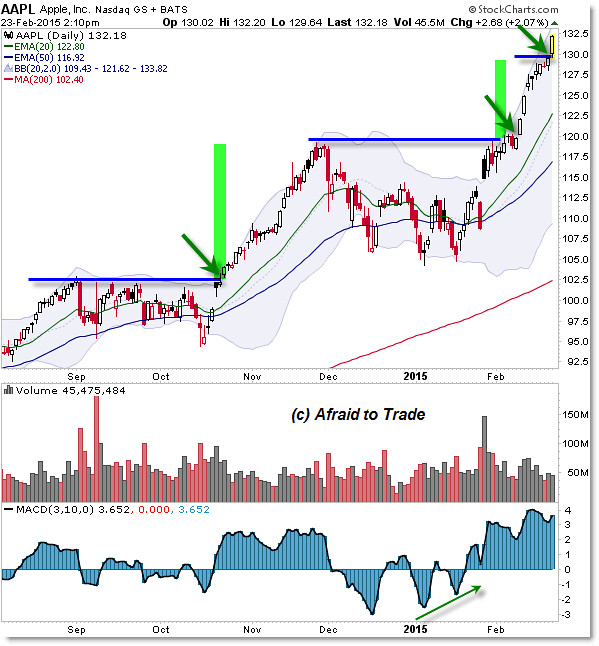Buying Apple AAPL on Breakouts to New Highs
Apple (AAPL) shares broke strongly to new all-time highs today, leaving some traders thrilled and others frustrated for missing out.
While most traders avoid buying breakouts, others see them as great opportunities to join a strong trend.
Let’s take a quick look at the current breakout as well as how shares have performed at prior breakouts.

The Daily Chart above shows two prior breakouts – October 2014 and now February 2015 – and the resulting straight-up movement that accompanied the breakout.
Keep in mind that price trends continue first from buyers buying (bulls) but also from sellers (bears) buying, but for a very different reason.
Buyers enter trades to profit from expected upside movement, but short-sellers must buy-back positions at a loss when their stop-losses are triggered.
Because many traders logically place stops above resistance levels, stop-losses… which are really just “buy” orders… can be triggered rapidly when price breaks resistance and triggers the stops.
This is the type of logic that fuels powerful trends and short-term breakout trading opportunities.
Price recently triggered the latest short-term resistance breakout above $130 per share.
We’ll pull the perspective back for a clearer look at price and prior breakout events:

Apple (AAPL) is an example of our concept of “Strong Stocks Getting Stronger.”
Not only has the trend been bullish (except for late 2012) but price has continued with a series of higher highs and lows.
The safest way to enter positions into a strongly trending stock is to buy shares on pullbacks or retracements.
“Flag” or retracement trades offer clear spots of entry and good places to locate a stop-loss in the event price fails to bounce higher, and instead breaks a support level (to trigger the stop-loss).
However, Breakout Trades trigger not when price “pulls back” but when it breaks out, either to new all-time highs or above a hand-drawn sideways resistance trendline.
We can see seven events where Apple shares broke short-term horizontal trendlines as it continued its uptrend.
Stops are often placed under the breakout trendline and the goal is to hold the position as long as possible, exiting when price breaks under a rising trendline or a stop that has been trailed under a rising moving average.
The plan is to enter a powerful impulse and profit from the short-term supply/demand (seller/buyer) imbalance.
Always monitor price closely and don’t be afraid to enter strong trends on breakouts – and never short a strong stock that is breaking out (that’s a great way to lose money quickly).
Corey Rosenbloom, CMT
Afraid to Trade.com
Follow Corey on Twitter: http://twitter.com/afraidtotrade
Corey’s book The Complete Trading Course (Wiley Finance) is now available along with the newly released Profiting from the Life Cycle of a Stock Trend presentation (also from Wiley).


One Comment
Comments are closed.